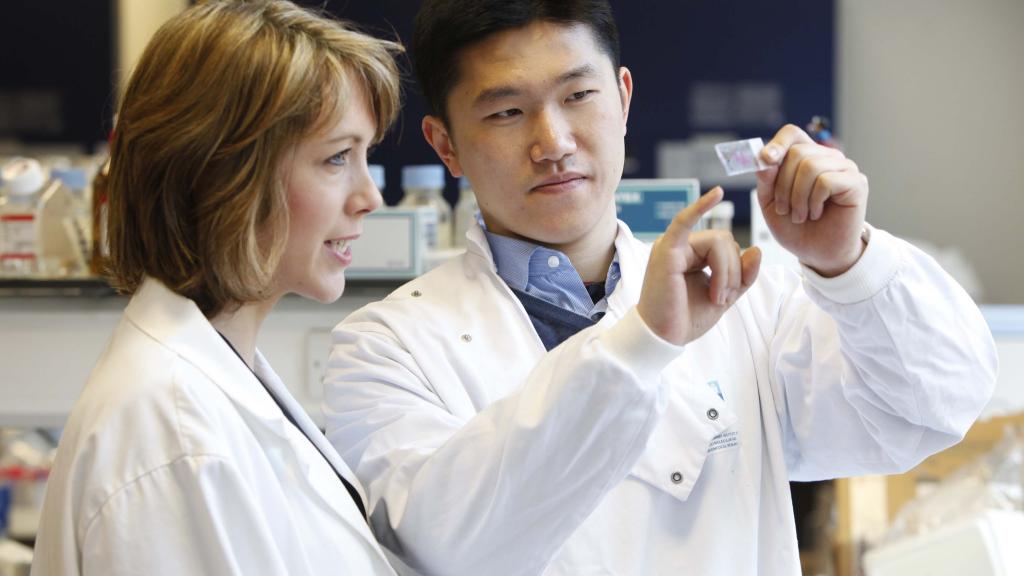
Work of Irish scientists has the potential to greatly improve prostate cancer detection
Irish scientists have developed a new and innovative device which they are using to test a newly proposed method for the detection of prostate cancer, which should offer a significant improvement in tumour detection compared with existing methods.
Using a specially constructed life-size ‘phantom’ test device which mimics the prostate and entire pelvic area, the researchers have been fine-tuning this new technique in advance of it being offered to patients in St James’s Hospital, Dublin, in a pilot clinical study.
[[{"type":"media","view_mode":"media_large","fid":"6412","attributes":{"alt":"Irish Cancer Society-funded researcher Silvin Knight","class":"media-image","style":"width: 200px; height: 321px; float: right; margin: 2px;"}}]]This research has been performed by Silvin Knight, a PhD student in the Imaging Physics Group, School of Medicine, Trinity College Dublin and the National Centre of Advanced Medical Imaging (CAMI), St James’s Hospital, working under the supervision of Professor Andrew Fagan, the Director of Imaging Physics in the CAMI centre and head of the group. Silvin’s work has been funded by the Irish Cancer Society and the Movember Foundation, and was recently published in the journal ‘Physics in Medicine and Biology’.
Prostate cancer is the most common cancer among men in Ireland with around 3,400 new cases of the disease identified each year. This makes up almost one third of all cancers diagnosed in men in Ireland.
The new detection technique builds on the dynamic contrast enhanced (DCE) form of MRI (magnetic resonance imaging) proposed almost 20 years ago by scientists. This involves the injection of a ‘dye’ into a patient and taking a series of images as the dye leaks in and out of tissue in the prostate.
As cancerous prostate tissue tends to be leakier than healthier tissue, the identification of leakier blood vessels in prostate tissue strongly indicates the presence of a tumour.
DCE-MRI has been demonstrated in research studies to potentially offer a significant improvement in prostate cancer detection (of up to +42% in sensitivity, compared with biopsy alone), but to date scientists have been unable to properly test the technique’s accuracy, and so this potentially life-saving approach to prostate cancer detection has remained confined within a research setting.
The research team’s test device will finally provide vital information on the effectiveness of DCE-MRI, while allowing the team to see the results of an improved version of DCE-MRI they are currently developing, which involves ‘compressed sensing’. This new technique uses advanced mathematics to determine the manner in which the DCE-MRI images are acquired and in how they are subsequently analysed in order to detect and determine the aggressiveness of the prostate tumour. The research team’s work should dramatically increase the possibility of DCE-MRI being incorporated into routine clinical examinations of the prostate, to the benefit of patients.
Commenting on the project, Silvin said:
“Currently it is difficult for doctors to definitively diagnose prostate cancer using existing techniques. These usually require patients to go through a painful and sometimes inaccurate biopsy procedure.
“Using this new ‘phantom’ device will finally allow us to answer questions that have long eluded researchers about DCE-MRI. We can then build on these answers by trialling our improved ‘compressed sensing’ version of DCE-MRI.
“In the coming months we will run a small pilot study in St James’s Hospital to test this new form of detection, and hope to recruit some patients onto this trial. It will compare our new CS-DCE-MRI technique with existing biopsy results, with other imaging techniques, and with the analysis of removed prostates, to determine the level of improvement in prostate cancer detection.”
Nine in ten prostate cancer patients survive their diagnosis after five years. However, early detection is a huge factor in saving lives. Currently the first tests men will undergo to detect if they have the disease involves PSA blood test – which measures a protein made by the prostate gland called prostate specific antigen – and a digital rectal examination.
Dr Robert O’Connor, Head of Research with the Irish Cancer Society, praised the development as hugely significant:
“I would like to congratulate Silvin and the research team which has brought this important development in prostate cancer detection into fruition. Together with the Movember Foundation, the Irish Cancer Society is proud to support Silvin in his vital work which has the potential to save men’s lives.
“The Irish Cancer Society and Movember could not invest in projects like Silvin’s without the generous support of the public. For more than 50 years the Irish Cancer Society has invested in cancer research, and since 2008 we’ve partnered with Movember in the funding of a number of vital prostate cancer research projects. All across the country we have funded doctors, nurses and scientists who are looking for new advances to overcome prostate cancer through research.
“Our research programmes focus on finding new ways to help men who have been diagnosed with prostate cancer, ensuring the most advanced personalised treatment options are available and that as many patients as possible thrive after their treatment. In Ireland one in eight men are at risk of developing prostate cancer so more research is vital in order to tackle this growing epidemic of prostate cancer.”
In order to continue to invest in prostate cancer research the Irish Cancer Society and the Movember Foundation need the public’s continued support.
This month the Irish Cancer Society has once again partnered with Movember Foundation Ireland to raise awareness around prostate cancer and other men's health issues, as well as raise urgent funds to support life-saving cancer research and care for men and their families.
Learn more and get involved at ie.movember.com.
For more information about prostate cancer, visit www.cancer.ie/prostate.
